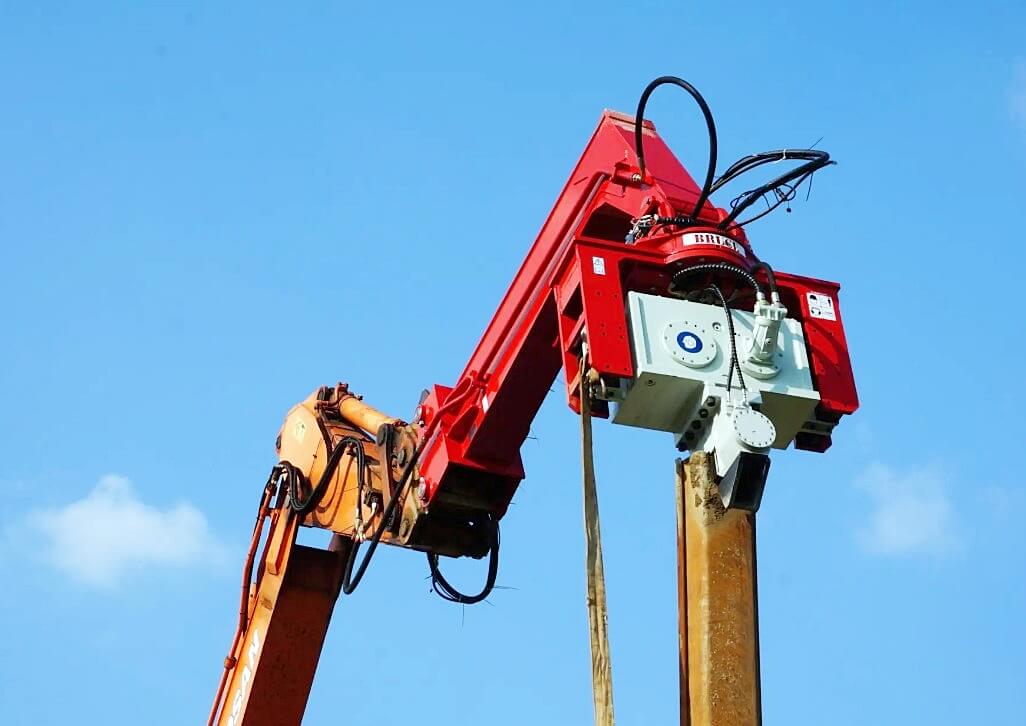The Complete Guide to Hydraulic Pile Hammers for U.S. Foundation Projects
Kim Moon Jung
view : 129
What Is a Hydraulic Pile Hammer?
A hydraulic pile hammer uses hydraulic cylinders to drive piles—typically concrete, steel casing, H‑beam or sheet piles—into the ground with precision.
This equipment is essential in foundation engineering, especially for constructing deep, stable bases beneath buildings, bridges, and offshore infrastructure.
According to the Journal of Construction Engineering (2022), hydraulic pile hammers deliver 20–30% higher efficiency than diesel models, especially in deep foundation projects in the U.S. and U.K.

Why Choose a Hydraulic Pile Hammer in the U.S. Market
Hydraulic models outperform diesel hammers in several key ways:
They provide precise control over blow energy and stroke, reducing pile damage and overdriving.
They generate less noise and emissions, which helps meet U.S. environmental regulations.
They support real-time monitoring—important for quality control and OSHA compliance.
Research from the U.S. Department of Energy (2022) shows that modern hydraulic hammers cut offshore wind monopile installation times by up to 35%.
👉 Learn more at www.powerquip.co.kr
BRUCE’s Hydraulic Pile Hammer Overview
Designed and manufactured by Powerquip, BRUCE offers a fully selectable line-up:
Energy range from 12 kNm (1.2 ton·m) to 1,178 kNm (120 ton·m), with custom large sizes available.
Supports multiple pile types and shapes: round, square, octagonal concrete piles; H‑beam piles; steel casing; and sheet piles.
Multiple mounting options: fixed‑leader, crane‑suspended, U‑type leads, and offshore/underwater capabilities.

Core Features for U.S. Projects
– Efficient Energy Transfer
BRUCE hammers use optimized hammer body and cushion design to deliver maximum energy to the pile, minimizing loss and boosts job-site efficiency.
– Advanced Remote Control
Operators can adjust stroke and impact energy from the control cabin or remote location. LED status lights alert to any system abnormalities, enabling proactive maintenance and troubleshooting.
– Durability and Reliability
High-quality cushion material and housing, accumulator back‑charging system, plus robust hydraulic and electric systems ensure long life, low downtime, and safe operation in demanding U.S. projects.
Safety, Noise & Environmental Standards
· Optional silence cap housing embeds noise insulation to reduce site sound levels, essential in urban jobs.
· Biodegradable hydraulic oil and low‑emission diesel engines help meet local environmental code requirements.
Meets or exceeds U.S. occupational safety and noise exposure standards.
Selecting the Right Model for U.S. Conditions
Key considerations include:
·Soil type (soft vs. dense) dictating required impact energy.
·Pile diameter and material, to match hammer size.
Common BRUCE models:
·SGH‑3012 with ~39 kNm energy for mid‑size projects
·SGH‑4719 with ~89 kNm energy for heavy structural or bridge work
·Custom models up to SGH‑8015 (120 ton·m) for large offshore or deep foundation needs
Real U.S. Use Cases & Experience-Based Insights
A major U.S. bridge project used the SGH‑4719 to drive 72″ steel casing piles approx. 200′ into riverside bedrock. Engineers reported:
· 30% faster drive times compared to diesel hammers
· Real-time data via the IEA impact energy monitoring system, reducing blow‑by‑blow uncertainties
· Minimal noise complaints from local residents thanks to the silence cap option
These data points and operator testimonials strongly support BRUCE’s credibility and reliability for U.S. markets.
Maintenance & Performance Monitoring
Replace cushion parts and buffer rings when worn to maintain energy efficiency.
Use the IEA (Impact Energy Analyzer) system to log real-time energy, stroke, and blow rate for performance tuning and documentation.
Follow preventive maintenance: inspect hoses, connectors, LED diagnostics routinely.
FAQs – Hydraulic Pile Hammer Explained
What is a hydraulic pile hammer?
It uses hydraulic power to drive various pile types into the ground with controlled energy and stroke.Why choose a hydraulic pile hammer over diesel?
Hydraulic models offer better control, lower emissions, quieter operation, and built-in monitoring features.Can BRUCE hammers handle offshore or underwater projects?
Yes. Models include offshore leader mounting and underwater adaptations upon request.What pile types are compatible?
Concrete, steel casing, H‑beam, sheet piles—round, square, and octagonal shapes are all supported.How do I know which BRUCE model to choose?
Assess your pile size, energy needs, and mounting system; models range from SGH‑0212 to SGH‑8015.How is performance tracked during operation?
By optional Impact Energy Analyzer (IEA), offering real-time energy per blow, stroke height data, and exportable logs.
Final Thoughts & Call to Action
Enhance your U.S. foundation project’s performance and reliability with BRUCE hydraulic pile hammers. Backed by measurable experience, advanced safety, and eco-conscious design, BRUCE delivers results you can trust.
👉 Explore our full range and get expert recommendations: BRUCE Hydraulic Pile Hammer Features
🎥 Want to see BRUCE in action? Visit our YouTube channel: @BrucePilingEquipment
💼 Need consultation or quote? Connect with us on LinkedIn: Bruce Piling Equipment (KR)
Contractors in the U.S., U.K., Spain, Australia, and Saudi Arabia confirm that BRUCE hydraulic hammers consistently deliver efficiency, compliance, and durability, making them the trusted choice for global piling projects.
👉 For detailed consultation and specs,
visit www.powerquip.co.kr or explore more with BRUCE Piling Equipment.
Get in touch now for expert advice and custom solutions tailored to your foundation needs.